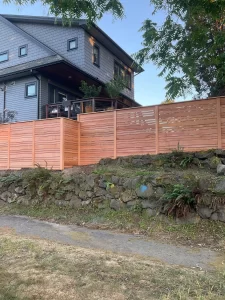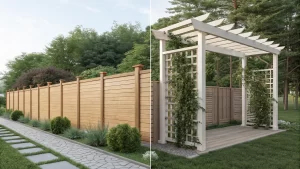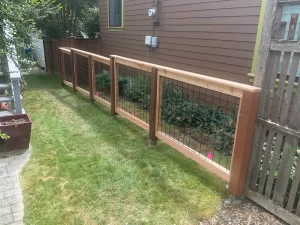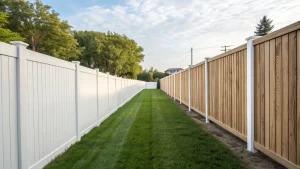Vinyl fences promise privacy and a polished look — until the first gap shows up. Maybe you let the dog out and suddenly he’s halfway under the fence 🐾. Or you spot a raccoon slipping through at night. Even a small opening can make a backyard feel less private, less secure, and a little more stressful than it should.
This leads to the critical question: what is the most effective way to seal a gap under a vinyl fence? The answer is rarely obvious. In Seattle’s damp climate and on its sloped landscapes, a quick DIY patch might hold for a season, but the wrong fix can often make drainage or aesthetic problems worse, failing to provide the lasting security or polished look homeowners want.
This guide will not only outline the best materials and methods to fill the gap under a vinyl fence but will also explain how to choose the right approach for your specific landscape and needs.
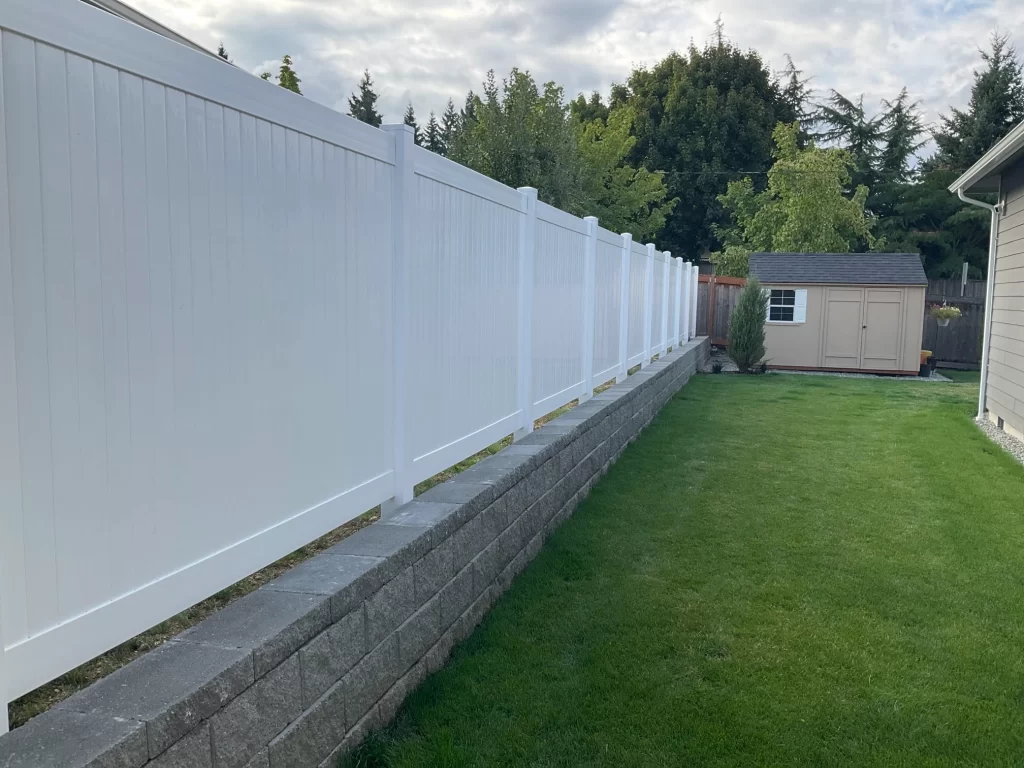
The Root of the Problem: Why Gaps Appear
If you’ve noticed spaces forming at the base of your vinyl fence, you’re not imagining things — it’s one of the most common complaints homeowners in the Seattle area bring to us. These gaps don’t always show up right away. Sometimes they appear within months of installation, other times they creep in years later. But no matter when they happen, they all trace back to the same set of challenges.
Seattle’s varied terrain is a big culprit. Few yards are perfectly level, and even a small slope can make installation tricky. Add in our soggy winters, shifting soils, and the occasional freeze-thaw cycle, and suddenly that straight, tidy line of panels has small spaces where you least want them. Over time, erosion and ground settling make those spaces wider.
Another factor is installation itself. If the posts aren’t anchored deep enough or the panels aren’t adjusted properly, the ground may shift faster than the fence can handle. That’s when you start wondering how to cover gap under vinyl fence without making it look like a patch job.
The truth is, gaps are natural — but they don’t have to be permanent. With the right approach, you can eliminate them in a way that blends seamlessly with the design of your fence while keeping your yard private and protected.
Securing the Foundation: Why Posts Matter Most
Your vinyl fence is only as strong as its posts. When posts shift, panels rattle, gaps widen, and the whole line starts to feel unstable.
Seattle’s wet soil makes this a common problem. Even small shifts from erosion or freeze-thaw cycles can tilt a post just enough to cause trouble. Left unchecked, that lean grows worse every season.
So how do you keep vinyl fence posts secure?
- Depth is everything. Posts should be set at least 30 inches deep in Seattle’s climate (sometimes more on sloped or loose soil). Shallow installs are the #1 reason fences fail early.
- Gravel + concrete combo. Pouring concrete alone can trap water. Adding a 6″ gravel base under the post allows drainage and helps the concrete footing stay solid.
- Slope the top of concrete. When setting posts, angle the concrete cap slightly away from the post. This prevents water from pooling — a small trick that greatly extends stability.
- Check the “wobble test.” Give your posts a firm shake every few months. If you notice movement, address it early by tamping soil, adding gravel, or calling a pro before the problem spreads down the line.
- Use sleeves on weak soil. In especially soft or sandy yards, steel post sleeves or reinforcement inserts can add strength inside hollow vinyl posts.
⚠️ Pro tip: More concrete doesn’t always mean stronger posts in Seattle — drainage is what keeps them stable.
DIY fixes to skip in Seattle:
Quick fixes like rocks, foam, mulch, or scrap boards might seem convenient, but the rain, shifting soil, and freeze-thaw cycles will undo them fast. Rocks and boards shift, foam cracks, and mulch decomposes — often leaving the gap worse than before.
✅ Lifehack: If you want to see if a gap is actively worsening, drop a golf ball under the fence after a rain. If it rolls through, the soil is shifting — time to call a pro or reinforce the post. Once reinforced properly, posts rarely cause issues again — which means fewer gaps and a fence that feels solid year after year.
At Inline Fence, we always reinforce posts with Seattle’s rain and shifting soil in mind. Whether it’s resetting a wobbly base or installing new posts with the right drainage and depth, we make sure the “backbone” of your fence stays strong for the long haul.
Practical Ways to Close Fence Gaps (That Actually Work in Seattle)
Not every “hack” you find online will survive a season of rain and shifting soil. But if you’re looking for ideas before committing to professional reinforcement, here are the methods that hold up best:
- Concrete or Curb Filler
For homeowners who want a permanent solution, poured concrete or pre-formed curb fillers create a solid base under the fence. It locks out pests and prevents erosion, though it should only be done once the fence is perfectly aligned. - Steel Mesh
A favorite for pet owners, galvanized mesh can be secured along the bottom of your fence to block gaps. It’s dig-resistant, durable, and blends in when installed neatly. - Soil + Shrubs
Mounding soil under the fence and planting dense shrubs in front can both disguise and secure gaps. Shrubs add stability through their root systems while also enhancing curb appeal. - Decorative Pavers
Flat stepping stones or pavers can be tucked into gaps for an instant improvement. When installed in a continuous line, they double as a low garden border and provide a clean finish.
⚠️ Pro Tip: Skip soft fillers like mulch, foam, or fabric in Seattle. They rarely last through wet winters and usually mean re-doing the job the next season.
📌 Seattle Pro Insight: Homeowners here often see the longest-lasting results with concrete or steel mesh, since both hold up against rain, shifting soil, and pets. Shrubs and pavers work well too, but they may need occasional upkeep.
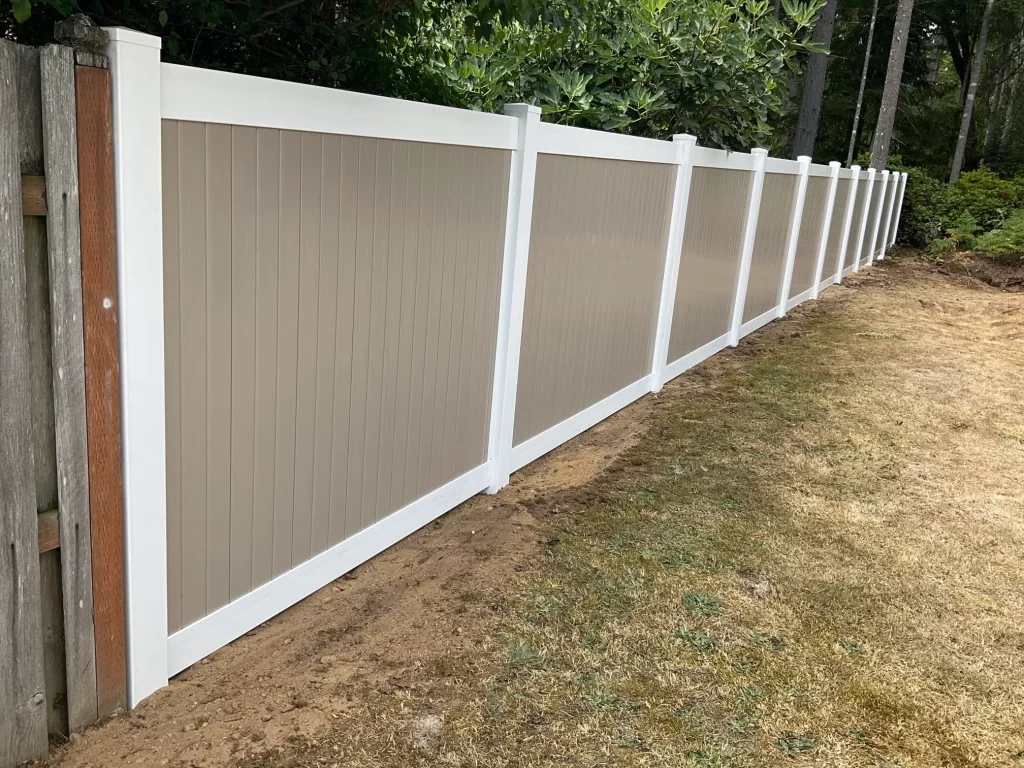
Seattle-Specific Insights You Won’t Find in Generic Guides
Seattle’s beauty comes with quirks that directly affect fences. The city’s combination of year-round rain, soft soils, and sloping yards creates conditions that homeowners in drier places never have to think about. Here’s what that really means for your vinyl fence:
- Rain + Roots = Movement. Constant moisture doesn’t just soften the ground — it also encourages root growth. Tree roots can push posts out of alignment over time, especially near property lines. Smart placement (or installing root barriers) prevents a lot of headaches.
- Drainage is more important than concrete. Many people assume pouring more concrete means more stability. But in Seattle, the secret is actually drainage. Without a gravel base or sloped cap, water pools around posts, slowly washing soil away. That’s why so many fences look fine for a few years and then suddenly lean.
- Slope stress. On hills, panels act like sails in the wind, putting extra strain on posts. Installing shorter sections or stepped panels instead of forcing one long run helps reduce this pressure and prevents premature shifting.
📌 Myth-buster: Using mulch or foam to fill gaps doesn’t seal anything long-term — in Seattle, it usually invites pests and more work.
- Freeze-thaw surprise. While Seattle isn’t the Midwest, cold snaps still happen. When waterlogged soil freezes, it expands and pushes posts upward. Adding drainage gravel or sleeves around posts helps absorb that movement and keeps them in place.
- DIY fix killer: mulch & foam. In our damp climate, mulch breaks down fast and foam hardens, then cracks with soil shifts. Both invite rodents too. Homeowners often think they’ve “sealed the gap” only to be back at square one by the next rainy season.
⚠️ Pro tip: In Seattle, the best long-term solutions are a mix of structure and landscape. Pairing posts set deep with drainage-friendly bases, then softening the look with shrubs or pavers, gives you both durability and curb appeal.
When you work with a local installer who understands these micro-challenges, your fence doesn’t just survive Seattle’s conditions — it thrives in them. That local know-how is the difference between a fence that feels “patched together” and one that looks intentional and lasts for decades.
Professional Solutions That Last
A fence only performs as well as the care behind it. At Inline Fence, we start by evaluating your property’s slope, soil, and drainage before recommending a fix — because no two Seattle yards face the same challenges.
For gaps under vinyl fences, we install custom-fit materials that blend with your fence line instead of looking like a patch. Posts are reinforced from the start, and if yours have already loosened, we stabilize them so they stay upright season after season. By addressing the foundation, gaps stay closed and the fence holds its strength long-term.
DIY gap-fillers like rocks, foam, or boards often look temporary — and worse, Seattle’s wet soil can undo them within months. Our solutions avoid that cycle, giving you a polished finish that lasts.
We also offer more than vinyl. Cedar adds warmth, Horizontal Wood brings modern lines, Hog Wire balances openness with security, Chain Link offers durability, Ornamental Iron delivers elegance, and Steel Metal Panels provide unmatched strength. Add-On customizations ensure each design fits your property and lifestyle.
Whichever material you choose, the goal is the same: a fence that looks intentional, keeps your yard secure, and withstands Seattle’s rain, wind, and shifting soil.
Ready to Close the Gap?
Small gaps and loose posts might seem minor at first, but they can quietly undermine your privacy, security, and peace of mind. The good news is that these problems are completely solvable — with the right expertise and professional approach.
At Inline Fence, we specialize in creating vinyl fences that don’t just look good on day one, but continue to perform for years. From addressing gaps at the base to reinforcing posts against Seattle’s rainy, shifting soil, we ensure every fence line is secure, polished, and built to last. Your yard should be a place of relaxation and enjoyment — not a source of constant worry about pets, neighbors, or weather-related damage.
👉 Get your free, no-pressure quote today! Let us take care of the details, close the gaps, and give you the secure, private, and worry-free fence your home deserves.


